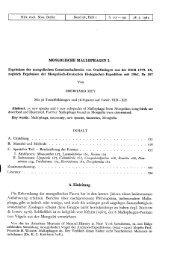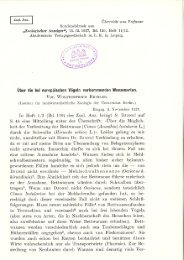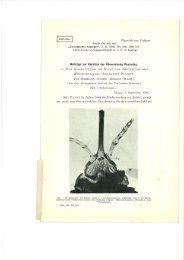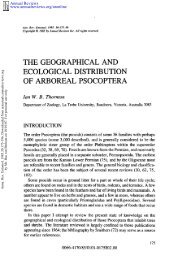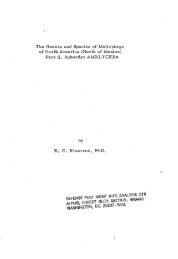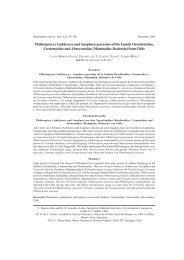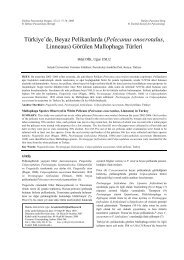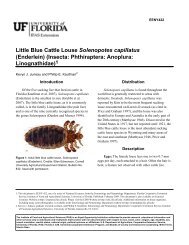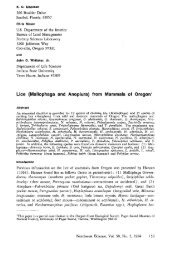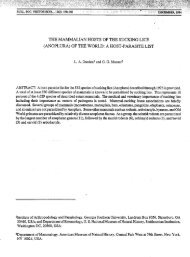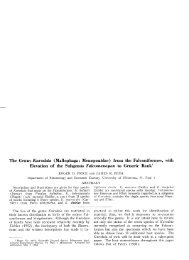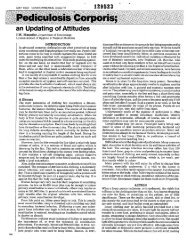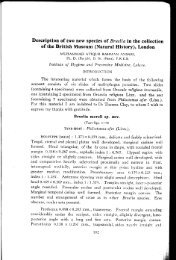The population dynamics and host utilization of ... - Phthiraptera
The population dynamics and host utilization of ... - Phthiraptera
The population dynamics and host utilization of ... - Phthiraptera
Create successful ePaper yourself
Turn your PDF publications into a flip-book with our unique Google optimized e-Paper software.
288 R.W. Rust<br />
parasite, the biotic parameters are in general related to or originate from<br />
the <strong>host</strong>. <strong>The</strong> degree <strong>of</strong> adaptation <strong>of</strong> the parasite to the biotic parameters<br />
corresponds to the <strong>host</strong> specificity <strong>of</strong> the parasite. <strong>The</strong> degree <strong>of</strong> <strong>host</strong><br />
specificity also indicates the adaptations <strong>of</strong> the parasite to the abiotie<br />
parameters influencing the <strong>host</strong>. Mallophaga, biting lice, are <strong>host</strong> specific<br />
(Hopkins, 1949; Werneck, 1950), <strong>and</strong> the restriction <strong>of</strong> all life stages to<br />
the body <strong>of</strong> the <strong>host</strong> refines the specificity <strong>and</strong> adaptations <strong>of</strong> a louse to<br />
its <strong>host</strong> <strong>and</strong> <strong>host</strong>'s environment (see Clay, 1949; Ash, 1960; Baum, 1968;<br />
Foster, 1969, for avian lice; Ewing, 1924; Hopkins, 1949; Waterhouse,<br />
1953; Craufurd-Benson, 1941; Scott, 1952; Murray, 1957b-d, 1965;<br />
Hopkins <strong>and</strong> Chamberlain, 1969, for mammalian lice). For lice, the<br />
combination <strong>of</strong> interacting mortality factors <strong>and</strong> a species innate capacity<br />
for increase will determine the <strong>population</strong> level on a particular <strong>host</strong>.<br />
Evans <strong>and</strong> Smith (1952), in their classic demographic analysis <strong>of</strong> Pedi.<br />
culus humanus Linnaeus, were the first to study the reproductive potentials<br />
<strong>of</strong> an ectoparasite. Murray <strong>and</strong> Gordon (1969) modeled the <strong>population</strong><br />
<strong>dynamics</strong> <strong>of</strong> Bovicola ovis (Linnaeus), a biting louse <strong>of</strong> sheep. <strong>The</strong>y<br />
showed mathematically the development <strong>of</strong> the <strong>population</strong> from a low<br />
summer density to a winter high density.<br />
<strong>The</strong> genus Geomydoecus, parasites <strong>of</strong> the fossorial rodent family<br />
Geomyidae, possesses morphological adaptations not found in other<br />
trichodectid lice (Ewing, 1936). Degenerate adaptations as the absence<br />
<strong>of</strong> eyes <strong>and</strong> lack <strong>of</strong> abdominal spiracles <strong>and</strong> tergites might be a response<br />
to the altered conditions <strong>of</strong> the <strong>host</strong>'s burrow environment (Kennerly,<br />
1964; McNab, 1966; Darden, 1970), <strong>and</strong> specializations <strong>of</strong> the antennae<br />
<strong>and</strong> well-developed hair-groove could relate to life on the gopher. Recently,<br />
Price <strong>and</strong> Emerson (1971) studied Geomydoecus <strong>and</strong> found 45 taxa<br />
on 29 <strong>of</strong> the 36 species <strong>of</strong> gophers. Most gophers have only one louse<br />
species; exceptions were <strong>host</strong>s with extensive geographical distributions.<br />
<strong>The</strong> relative accessibility, small size, <strong>and</strong> peculiar habitat <strong>of</strong> the <strong>host</strong><br />
provide a system for analyzing a parasite's <strong>population</strong> <strong>dynamics</strong>. Thus,<br />
Geomydoecus oregonus Price <strong>and</strong> Emerson, a parasite <strong>of</strong> Thomomys bottae<br />
(Eydoux <strong>and</strong> Gervais), was selected for analysis <strong>and</strong> interpretation.<br />
Methods <strong>and</strong> Materials<br />
Field<br />
A minimum <strong>of</strong> 20 pocket gophers per month as live-trapped from two irrigated<br />
alfaHa fields located on the University <strong>of</strong> California, Davis Farm, <strong>and</strong> 2 consecutive<br />
months <strong>of</strong> collection data were combined for analysis. <strong>The</strong> field sizes, agricultural<br />
practices, measurement <strong>of</strong> environmental parameters, gopher collecting <strong>and</strong> laboratory<br />
h<strong>and</strong>ling techniques <strong>and</strong> parasite recovery methods are treated in Rust<br />
(1973a, b).<br />
Three age classes were established for both sexes <strong>of</strong> gophers: juvenile, subadult<br />
<strong>and</strong> adult. Separation was based on reproductive condition, skull features, <strong>and</strong> body



